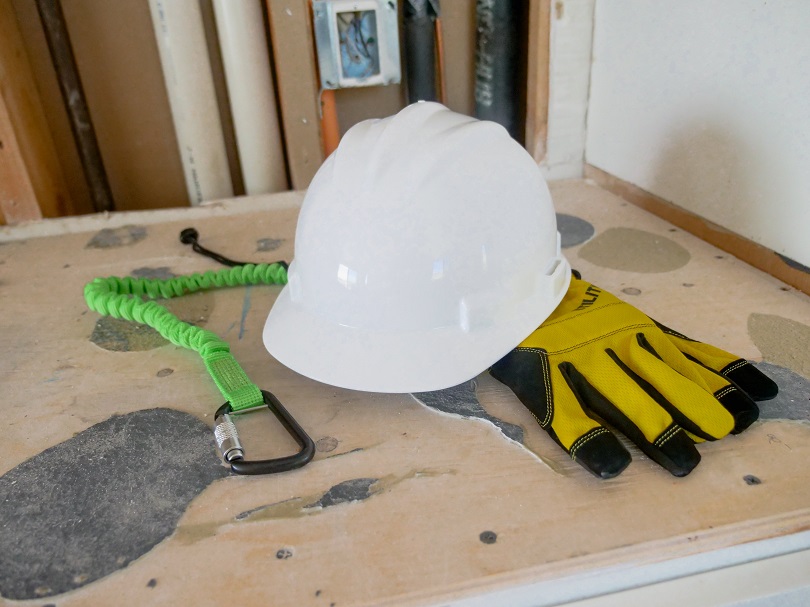In todays toolbox talk we will discuss about an essential and maybe one of the most important aspects of our safety on the job site – the importance of wearing hard hats. Safety helmets might seem like a simple piece of safety equipment, but they play a vital role in protecting our most valuable asset: our heads.
Why Hard Hats?
Let’s see below the main reasons why wearing hard hats is a non-negotiable safety control and how to have them in good condition for protecting our life.

Protection from Falling Objects:
One of the primary purposes of a hard hat is to shield your head from falling objects. Whether it’s a tool, a piece of equipment, or materials, accidents can happen at any time. Wearing a safety helmet significantly reduces the risk of head injuries caused by falling objects.
Prevents Head Injuries:
In a construction environment, head injuries are among the most severe and life-threatening. Hard hats are designed to absorb and disperse the force of an impact, reducing the likelihood of skull fractures, concussions, and other traumatic head injuries. They serve as your personal helmet, guarding against unforeseen incidents.
Protection from Overhead Hazards:
Besides falling objects, many job sites have overhead hazards like scaffolding, pipes, and low ceilings. Safety helmets provides a protective barrier between your head and these hazards, reducing the risk of accidental head contact.
Electrical Safety:
Some job sites involve electrical work, and hard hats with electrical resistance properties can save your life in case of an electrical accident. These hard hats are designed to prevent electrical currents from passing through them, keeping you safe when working around live wires.

Sun Protection:
In outdoor work environments, hard hats also provide protection from the sun. Extended sun exposure can lead to heat-related illnesses, and wearing a safety helmet with a brim can help shield your face and neck from harmful UV rays.
Maintenance in Good Condition:
To ensure that the hard hats remains effective, it’s crucial to:
- Inspect them regularly for cracks, dents, or other signs of damage. If you find any, replace the hard hat immediately.
- Clean them using mild soap and water, avoiding harsh chemicals that can weaken the material.
- Store them in a cool, dry place away from direct sunlight and extreme temperatures.
- Avoid modifying the hard hats with stickers, paint, or other materials that could compromise its integrity.
Expiration Date:
Hard hats have a limited service life, usually around five years from the manufacturing date. Check the manufacturer’s label inside the hard hat for the date of manufacture and calculate when it will expire. Replace your hard hat promptly when it reaches its expiration date or if it sustains significant damage.
In conclusion, wearing a hard hat is not just a safety requirement; it’s a responsibility to yourself, your family, and your colleagues. It’s your first line of defense against head injuries and a symbol of your commitment to workplace safety.
Remember, safety is a team effort, and we all have a role to play in ensuring everyone goes home safely at the end of the day. So, let’s make it a habit to wear our safety helmets consistently and correctly, and let’s be diligent in maintaining them in good condition. Your safety helmet is your safety shield – wear it with pride and stay protected.
Important
The toolbox talks always must be a dialog and not a monolog. You need to be sure that all your team have a clear understanding of the discussed topics. ALWAYS ASK FOR FEEDBACK – THIS WILL HELP!

Comments
2 responses to “Toolbox talk Brief #6 – Hard Hats”
Very good topic, but must ask the question, most sites you arrive on today will give you a site induction, and to prove to everyone that you are inducted , they will give you a site induction sticker, now I know they will probably tell you the adhesive use will not contaminate the helmet, my question is HOW DO YOU KNOW!
Good day Michael, my point of view is related to manufacturer instructions which must be followed accordingly. If the manufacturer is prohibiting use of the stickers/ inscriptions on the helmets, then the instructions must be followed. Also the inspection and proper care of the helmet is essential.